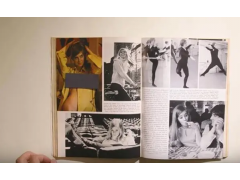
On March 19, 2020, PLAYBOY, which claims to have changed the way Americans live and have sex, announced that it will no longer be published in print, marking the end of the famous adult magazine's 66-year marketing era. In the letter, PLAYBOY CEO Ben Cohen said that as the impact of the COVID-19 pandemic has extended to parts of the magazine's supply chain, the company has decided, after discussion, to stop printing the publication after the spring 2020 issue and focus on updating the digital media space. But from time to time, special editions of PLAYBOY or some other form of physical publication come out.
It was sudden but not unexpected news. Rather than shutting down the magazine, the pandemic is just "the straw that broke the camel's back." This follows years of declining print sales of PLAYBOY, which are now only 4% of its peak of nearly 7 million copies sold in the 1970s. We also see that in the reign of digital media, the former print media giants are seeking to develop online, and PLAYBOY is unfortunately left behind.

Hefner and the Bunnies; Photo credit: Business Insider PLAYBOY was founded in 1953 in Hefner's kitchen by Hugh Hefner, who claimed to have "led the sexual revolution in America," with a starting capital of just $8,000. As a man who actively advocated open love and marriage relationships, Hefner used a large number of young female models in his magazine as the standard of "cute, lively and sexy", showing naked and bold adult pictures, advocating that people should get rid of Puritan and Victorian prudishness, and declaring that women should also join the ranks of men's "sexual liberation". "It's good for mental health," Hefner says.
At a time when birth control pills were still on the books in some states, Hefner's liberating desire spread like a spring shock to the states. In the first issue of PLAYBOY, "sex goddess" Marilyn Monroe "spread lust" on the cover and in the middle, which helped the magazine sell more than 50,000 copies in its first issue. Today, the book sold for only 50 cents is still the object of many fans.
As sales increased, Hefner invested more heavily in staff recruitment, and by the end of the 1950s PLAYBOY had sold millions of copies. More celebrities followed, including Madonna, Cindy Crawford and Barbra Streisand, as well as current US President Donald Trump, who appeared on the cover of the magazine in 1990.

The first issue of PLAYBOY; Photo credit: Business Insider PLAYBOY's sales were also helped by a decades-long lack of competition in the adult magazine space. During these decades, Hefner printed the bunny logo on a variety of industries, including gobs, clothing, and auto parts. In the 1960s, PLAYBOY's eponymous club opened all over the world. If you walked into a Miami "PLAYBOY Club" at that time, you could see 100 models dressed in bunny costumes. They will wear 6-inch heels, gracefully carry a tray, and serve you a sexy drink. PLAYBOY has since grown into a business empire that spans nightclubs and casinos.
Although the cover girl and the inside page model do attract attention, but Hefner more than "pornography", at a high fee to hire a list of famous writers for his inside page articles, including Hemingway, John Lennon, Maugham, Andy Warhol, Nabokov, Borges and so on, these articles are often in-depth cultural interviews, each interview as long as 7 to 10 hours. Interviews with John Wayne, Jimmy Carter, Martin Luther King Jr., Jean-Paul Sartre, and others. Many of the fans who bought PLAYBOY at the time came for these interviews, and some even considered PLAYBOY a serious literary magazine. "I never saw Playboy as a magazine that promoted sex," Hefner told CNN in 2002. "I saw it as a lifestyle magazine, and sex was an important part of that."

PLAYBOY's eponymous club In 1972, after the launch of PENTHHOUSE, an adult men's magazine, PLAYBOY did not show any decline, and the December issue of PLAYBOY sold 7.1 million copies, topping the list in the United States. Clearly, PLAYBOY's quality interviews and attractive offline business made it irreplaceable at the time. PLAYBOY, which embodies Hefner's freedom of sex and freedom of speech, has the influence of an "opinion leader" in the fields of food, fashion, sports, and consumption, and has become a representative of a bold and pioneering lifestyle.

PLAYBOY interview with the Beatles In the late 1970s, more competing magazines began to appear, but this was not the real reason for PLAYBOY's declining sales. As PLAYBOY's spiritual leader, Hefner himself stepped down after suffering a stroke in 1985, and his daughter Christine took the helm four years later. The loss of Hefner's "PLAYBOY" like a giant ship lost course, in June 1986, "PLAYBOY" all the club closed, in fact, before the closure of several years, the club has long been no longer profitable, in a long-term loss state.
The more important reason comes from the changing political climate and the rise of feminism. PLAYBOY's declaration of "Entertainment For Men" has become the object of criticism. Under the vision of feminism, female models with naked clothes and provocative gestures are more like the epitome of the "male gaze" and are the object objects to be objectified. To a certain extent, this has changed the society's aesthetic and purchasing methods for magazines.
In the 1990s, as DVDS entered more and more homes and recorded adult videos became a better option, magazine sales declined further. In the fifth decade of its business life, PLAYBOY made the fatal mistake of not going online in time for the rise of the Internet. To compensate, PLAYBOY began selling the rights to the bunnies, which became extremely popular in China and saved PLAYBOY nearly $1 billion in losses worldwide.
The revenue generated by the copyright was not enough to revive the empire Hefner had built. In 2005, Hefner and his three then-partners joined a reality show chronicling their lives that aired in 150 countries and lasted six seasons, making Hefner and the three women prominent in pop culture in the first decade of the 21st century. But the move did not yield long-term gains, with investors losing money for years in the face of plummeting sales. In 2017, the death of "spiritual leader" Hefner was also a heavy blow to PLAYBOY, and no matter what aspects of the change of social trends, the rise of female consciousness and the upgrading of adult entertainment, the "PLAYBOY" building will be irreversible.

PLAYBOY sales; Photo credit: Photo credit: Business Insider In 2018, PLAYBOY sold fewer than 300,000 copies and was losing millions of dollars a year. Several attempts were made to transform the magazine, featuring female activists on the cover and targeting younger Americans, without much success.
In the once struggling to survive the digital print media has gradually matured today, PLAYBOY is obviously not fortunate to share the online benefits of "a piece of the pie." But far from the end of the business empire Hefner built, scrapping the money-losing print edition of PLAYBOY could even be said to be a relief. The revenue from the copyright continues to flow, and the "Bunny" and "PLAYBOY" logos will continue to support Hefner's "business legacy."







